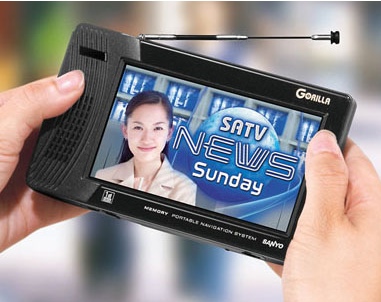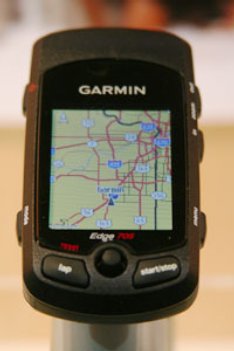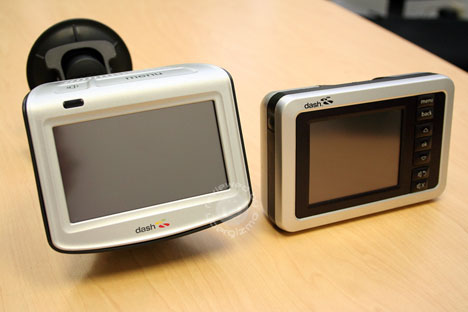TomTom GO 720 Full Review: "
The TomTom GO 720 is a solid product introduction that offers not only some feature improvements, but some innovative steps that shows TomTom positioning itself as an innovator in the GPS marketplace. TomTom is not afraid to step up and maintain its position in the upper echelon of GPS manufacturers. With this introduction, it is more obvious that TomTom is willing to develop products and software for the US market, where they previously brought over a nearly unaltered Euro product. The change is welcome and will make them more competitive in the US market where growth rates are still well north of 50% per year.
The TomTom GO 720 at the base is a
widescreen GPS navigation system that has a
SiRF star III chipset and text to speech capabilities. The unit comes with North American maps. The unit also offers
MapShare, a program to allow users to make minor alterations on their units, submit those changes, and if elected receive changes from other users who use MapShare. The TomTom GO 720 also has a fun feature to make your own recordings for the verbal navigation commands. Finally the unit also features a
‘Help Me!’ button that allows users get access information to quickly get help from police, service stations and hospitals.
Design
The TomTom GO 720 is unmistakably a TomTom, with familiar lines and design treatments that we’ve seen on the TomTom ONE XL. The unit has more upscale feel with metal accent finishes and a more refined look. The result of this and a longer life battery makes it a bit heavier, but still a unit that is very easy to carry around.
The suction cup mount is a ‘press-on’ variety, which is not my favorite, but works well with a diligent shove to get it on the windshield. Less valiant attempts may have it pop off if you aren’t serious about making it stick.

The mount itself has a minimal design to it, and the square piece on the mount slides into a channel on the back of the GO 720. At first, I was skeptical about its functionality, as you are essentially mounting this unit blind onto its mount, but the channel in the unit is deep enough to give you good tactile feedback and I generally got it mounted first try without issue.
The top of the unit has the power switch to the right side, which is set in a depression that guides your finger to it. The rear firing speaker is cleat and comes out right below the mount. On the rear, there is also an outlet for an external antenna.

One thing that I really like is the option to put the Menu Bar at the side of the screen, which for me, makes better use of the widescreen real estate. The map stays large vertically, and the key data is off on the side of the screen, all there, easy to get to. The only other improvement would be to be able to select which side to put it on (Right side only for now).
Across the bottom you have a TMC antenna input, the rest button, a USB input, and the SD card slot. The front of the unit offers metal accents and two small microphone holes that allow you to use the Bluetooth Handsfree feature and record your own verbal turn commands. While I did not have a TMC antenna for this review, I know that they are a simple thin wire addition that has its own suction cups to hold it to the windshield. I would love to see it integrated into the power cord like the Nuvi 660 unit.
MapShareMapShare is the program that was announced with the TomTom GO 720 that allows you the user to update maps; pure and simple. The changes that you can make are limited in nature, so you can’t draw a new road and then navigate it, but you can unblock roads, change their one-way status, and report issues with roads (not there, wrong place), as well as issues with points of interest (POI).
First, these general changes that you can make are immediately available to you on your GPS. If you would like to participate in the MapShare community, you can elect to opt in. If you do decide to participate in the community, you can share your changes and separately elect to receive changes from the community. There are different levels of scrutiny that you can set on your device. So for instance you can elect to include: Corrections made by you, Corrections that are Verified by TomTom, Corrections to a POI list that you subscribe to (think speed cameras), Corrections from trusted sources, corrections made by many, and corrections made by some. As you continue down the list you can see how the scrutiny goes down also. No word from TomTom on what the algorithm is to verify or set as a ‘Trusted Source’. But when you do submit corrections they will be done and tied to your GPS unit, so if there are erroneous changes made by you, your input will probably be tossed out.
Once you have set the GO 720 to participate in the MapShare community, you can elect to have a reporting button right on the map screen that will allow you to tap it and input an issue at any time. Might be overkill, but if you are encountering mapping issues that frequently, we might have a lot more work ahead of us than I first imagined. Once you do elect to make a correction, let’s say report a road in the wrong place, the process is easy to submit the change. The process is easy to walk through, pick a street off the map or by entering a name, and then type in the error from a pick list that includes items like wrong speed limit, in the wrong place, house numbers are wrong, etc. You also get the option to type in a short note that would be included in the submission, detailing further the issue.
I applaud the program, but can’t say that I have benefited on a day-to-day basis yet. The program is just getting going, and with the recent rollout of new software to the TomTom ONE XL that includes MapShare, things should start to really pick up steam.
Custom VoicesThe ability to record your own turn commands is a total gimmick, and one that I have to say makes the TomTom GO 720 much more enjoyable. I fell for it, I’ll admit it. The TomTom GO 720 has text-to-speech capability and will tell you the name of the street that you are turning onto through a computer representation of the street name. The performance is generally good. In order to use the custom voice recordings though, you will need to rely on the 56 set commands that do not say the name of the street.

The process of recording is brainlessly simple, and involves going into the Change Preferences menu, then Voice Preferences, and Record Voice. The TomTom 720 then recommends that you go somewhere quiet to record the voice tracks. The process can take about 15 minutes, and records voice tracks as *.wav files.
The process essentially takes you through a list of commands that are listed on the screen, you tap ‘Record’ and the unit then writes the data to its internal memory and you move onto the next phrase.
So, out of the 56 phrases, you have the ability to record what ever you want instead of the text that is written, but I will say that whatever you say for ‘Turn Right’ and ‘Turn Left’ had better be something that you like, because the GPS says them a lot of times…. Luckily for me our recording was pretty fun, so I though it was fun. It’s also fun to get several people to say the commands, because the TomTom will stitch phrases together to make up the command; ‘Turn Right, ‘Then’, ‘Get in the right lane’. Three Phrases, and fun to have three voices come across.
In order to get your voice as the chosen voice, you need to then go into Change Preferences -> Voice Preferences ->Change Voice, then select a voice (we selected Mandy), and you get a note that says:

‘You have selected a recorded human voice. Human voices cannot read messages or warnings aloud to you. Would you like a computer voice for reading messages aloud?’ Tap ‘no’. The unit then responds ‘Recorded Voice: You have recorded your own spoken instructions. Do you want to use your recordings?’ Tap ‘Yes.’ Now this will disable the reading of speed warnings, etc and the reading of street names, but it is definitely a lot of fun.
Navigation TomTom did their homework when they upgraded the destination input screens. The experience is much improved. The primary change is the move to a state based hierarchy that allows the unit to remember the last state that you were in/searched for.
The TomTom GO 720 allows you to navigate to your home, favorite, address, recent destination, Point of Interest, a point on the map, Lat/Lon coordinates, and the position of your last stop, i.e. where you left your car, or where you left your wallet at that last gas station. When searching for a Pint of Interest (POI) you can search near you, a POI in a city, a POI near home, a POI along route, and a POI near destination; all of these are tremendo9usly helpful in a GPS when narrowing what you want to search for and where. Who cares about a place to eat near you when you are looking for a good place to eat near your destination 20 minutes away? The TomTom GO 720 allows you to narrow your search, which is a big help.

When navigating to an address, as I said, TomTom has added a state based system to the GO 720. So, after searching, it will assume a state and display that two-letter abbreviation in the corner, making the assumption that you are searching in that state. Often times for me it is right, saving aggravation. A simple tap of that state abbreviation let’s you pick from a list or spell the state. Once you have a state, you can then spell the city. If you only want to hit a few letters, you can then hit the down arrow to the right of the state button to get rid of the keyboard and list 6 entries, making scanning through that list a lot easier.

Pick a town and you are all set to move onto the street name, etc. Instead of picking a house number, you can also at this point pick a cross street which will offer you a list of only the streets that cross, giving you some nice flexibility.
I thought that the navigation was solid and allowed me to navigate well with clearly spoken directions at appropriate times. In my torture test of navigating from my home near Boston to Dodger Stadium in Los Angeles, the TomTom came back with an interesting question, mentioning that it navigated via HOV lanes, and if that was OK. I indicated that it was not, and it recalculated the route, quickly and displayed the results in short order. The TomTom estimates a little long on the time estimate, which lines up with my experience in driving for more than a couple of hours with it. I had several routes that were 3+ hours with the TomTom, and it estimated a few minutes long, only to constantly revise down as I drove the routes.
Bluetooth HandsFreeThe TomTom GO 720 includes the ability to connect to your phone and offer you a handsfree connection for your Bluetooth capable mobile phone. The pairing with my Moto phone was easy, no directions required. Set the phone to discovery mode, have the TomTom search for it, and pair the two after typing in a password into the phone. I set them up to re-connect if separated. The TomTom GO was able to pull in the phonebook and recently made calls, and call quality was good. The phonebook does get pulled in as a list of all phone numbers, giving you several entries under one name, with no real designator as to ‘Home’ or Mobile’. Nicely the recent call list gets pulled in which is not always the case. Finally it is easy to also dial phone numbers from the POI listings where there are phone numbers associated with businesses, etc.
Review SummaryThe TomTom GO 720 represents a big step in innovation and customization for the US market. With State-based hierarchy in the address menu leading the charge I am happy to see some subtle but persistent issues disappear. The GO 720 is a solid navigator, and one that will get better with age, and not worse, as the MapShare program should continue to improve the quality of maps and POI as time goes on. While the ‘Help Me’ functionality is nearly ubiquitous in the top GPS devices, I applaud the work to add it to the units. For many, the GPS is a safety device that helps them feel secure, and this feature will go a long way to reinforcing that benefit. Not that I thought TomTom was ready to pack up their bags, but they are definitely here to stay and they are not shy about introducing easy to use, highly competitive GPS devices that will keep key rivals at the top of their game.
(Via GPS Lodge.)










 Mio is taking advantage of the combo of GPS and the digital camera in the DigiWalker C720T. Take a picture with the 2-megapixel cam on its back, and it becomes a navigable point of interest, so you can return to that one romantic spot (or the scene of the crime). This GPS navi, introduced today at DigitalLife, also has a TMC traffic receiver in its cradle (service free for 3 months; $65 per year after that). It's got a full media player and maps of Canada, US and parts of Mexico, including detailed navigation in Mexico City. Now shipping for $599
Mio is taking advantage of the combo of GPS and the digital camera in the DigiWalker C720T. Take a picture with the 2-megapixel cam on its back, and it becomes a navigable point of interest, so you can return to that one romantic spot (or the scene of the crime). This GPS navi, introduced today at DigitalLife, also has a TMC traffic receiver in its cradle (service free for 3 months; $65 per year after that). It's got a full media player and maps of Canada, US and parts of Mexico, including detailed navigation in Mexico City. Now shipping for $599




 Given that SatNav systems are one of the hottest items to steal these days, Medion's latest GoPal might go some way to redress the balance. Its P4425 model boasts fingerprint recognition for extra security, meaning that not only will thieves be unable to use it, but might find it that little bit harder to find out where you live &mdash unless, of course, your car is parked in your driveway when they break into your motor and steal it.
Given that SatNav systems are one of the hottest items to steal these days, Medion's latest GoPal might go some way to redress the balance. Its P4425 model boasts fingerprint recognition for extra security, meaning that not only will thieves be unable to use it, but might find it that little bit harder to find out where you live &mdash unless, of course, your car is parked in your driveway when they break into your motor and steal it.























 The
The 







